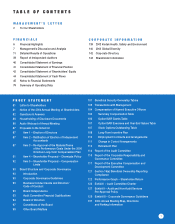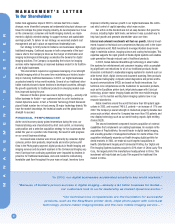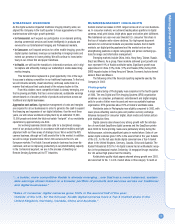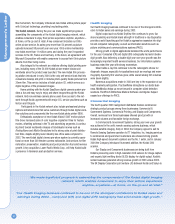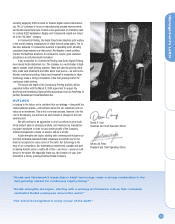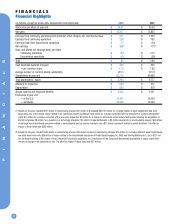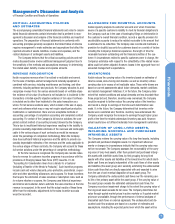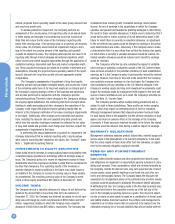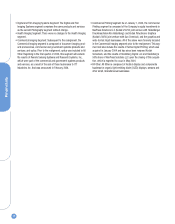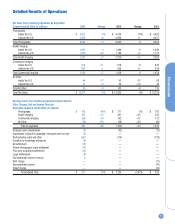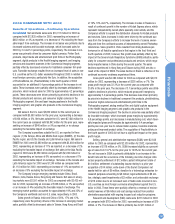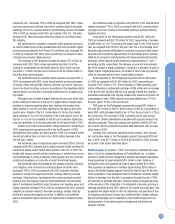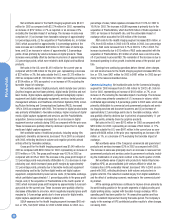Kodak 2003 Annual Report Download - page 7
Download and view the complete annual report
Please find page 7 of the 2003 Kodak annual report below. You can navigate through the pages in the report by either clicking on the pages listed below, or by using the keyword search tool below to find specific information within the annual report.
Financials
7
Management’s Discussion and Analysis
of Financial Condition and Results of Operations
CRITICAL ACCOUNTING POLICIES
AND ESTIMATES
The accompanying consolidated financial statements and notes to consoli-
dated financial statements contain information that is pertinent to man-
agement’s discussion and analysis of the financial condition and results of
operations. The preparation of financial statements in conformity with
accounting principles generally accepted in the United States of America
requires management to make estimates and assumptions that affect the
reported amounts of assets, liabilities, revenue and expenses, and the
related disclosure of contingent assets and liabilities.
The Company believes that the critical accounting policies and esti-
mates discussed below involve additional management judgment due to
the sensitivity of the methods and assumptions necessary in determining
the related asset, liability, revenue and expense amounts.
REVENUE RECOGNITION
Kodak recognizes revenue when it is realized or realizable and earned.
For the sale of multiple-element arrangements whereby equipment is
combined with services, including maintenance and training, and other
elements, including software and products, the Company allocates to, and
recognizes revenue from, the various elements based on verifiable objec-
tive evidence of fair value (if software is not included or is incidental to the
transaction) or Kodak-specific objective evidence of fair value if software
is included and is other than incidental to the sales transaction as a
whole. For full service solutions sales, which consist of the sale of equip-
ment and software which may or may not require significant production,
modification or customization, there are two acceptable methods of
accounting: percentage of completion accounting and completed contract
accounting. For certain of the Company’s full service solutions, the com-
pleted contract method of accounting is being followed by the Company.
This is due to insufficient historical experience resulting in the inability to
provide reasonably dependable estimates of the revenues and costs appli-
cable to the various stages of such contracts as would be necessary
under the percentage of completion methodology. When the Company
does have sufficient historical experience and the ability to provide rea-
sonably dependable estimates of the revenues and the costs applicable to
the various stages of these contracts, the Company will account for these
full service solutions under the percentage of completion methodology.
At the time revenue is recognized, the Company also records reduc-
tions to revenue for customer incentive programs in accordance with the
provisions of Emerging Issues Task Force (EITF) Issue No. 01-09,
“Accounting for Consideration Given from a Vendor to a Customer
(Including a Reseller of the Vendor’s Products).” Such incentive programs
include cash and volume discounts, price protection, promotional, cooper-
ative and other advertising allowances, and coupons. For those incentives
that require the estimation of sales volumes or redemption rates, such as
for volume rebates or coupons, the Company uses historical experience
and internal and customer data to estimate the sales incentive at the time
revenue is recognized. In the event that the actual results of these items
differ from the estimates, adjustments to the sales incentive accruals
would be recorded.
ALLOWANCE FOR DOUBTFUL ACCOUNTS
Kodak regularly analyzes its customer accounts and, when it becomes
aware of a specific customer’s inability to meet its financial obligations to
the Company, such as in the case of bankruptcy filings or deterioration in
the customer’s overall financial condition, records a specific provision for
uncollectible accounts to reduce the related receivable to the amount that
is estimated to be collectible. The Company also records and maintains a
provision for doubtful accounts for customers based on a variety of factors
including the Company’s historical experience, the length of time the
receivable has been outstanding and the financial condition of the cus-
tomer. If circumstances related to specific customers were to change, the
Company’s estimates with respect to the collectibility of the related receiv-
ables could be further adjusted. However, losses in the aggregate have not
exceeded management’s expectations.
INVENTORIES
Kodak reduces the carrying value of its inventory based on estimates of
what is excess, slow-moving and obsolete, as well as inventory whose
carrying value is in excess of net realizable value. These write-downs are
based on current assessments about future demands, market conditions
and related management initiatives. If, in the future, the Company deter-
mined that market conditions and actual demands are less favorable than
those projected and, therefore, inventory was overvalued, the Company
would be required to further reduce the carrying value of the inventory
and record a charge to earnings at the time such determination was
made. If, in the future, the Company determined that inventory write-
downs were overstated and, therefore, inventory was undervalued, the
Company would recognize the increase to earnings through higher gross
profit at the time the related undervalued inventory was sold. However,
actual results have not differed materially from management’s estimates.
VALUATION OF LONG-LIVED ASSETS,
INCLUDING GOODWILL AND PURCHASED
INTANGIBLE ASSETS
The Company reviews the carrying value of its long-lived assets, including
goodwill and purchased intangible assets, for impairment whenever
events or changes in circumstances indicate that the carrying value may
not be recoverable. The Company assesses the recoverability of the carry-
ing value of long-lived assets, other than goodwill and purchased intangi-
ble assets with indefinite useful lives, by first grouping its long-lived
assets with other assets and liabilities at the lowest level for which identi-
fiable cash flows are largely independent of the cash flows of other assets
and liabilities (the asset group) and, secondly, estimating the undiscounted
future cash flows that are directly associated with and expected to arise
from the use of and eventual disposition of such asset group. The
Company estimates the undiscounted cash flows over the remaining use-
ful life of the primary asset within the asset group. If the carrying value of
the asset group exceeds the estimated undiscounted cash flows, the
Company records an impairment charge to the extent the carrying value of
the long-lived asset exceeds its fair value. The Company determines fair
value through quoted market prices in active markets or, if quoted market
prices are unavailable, through the performance of internal analyses of
discounted cash flows or external appraisals. The undiscounted and dis-
counted cash flow analyses are based on a number of estimates and
assumptions, including the expected period over which the asset will be

